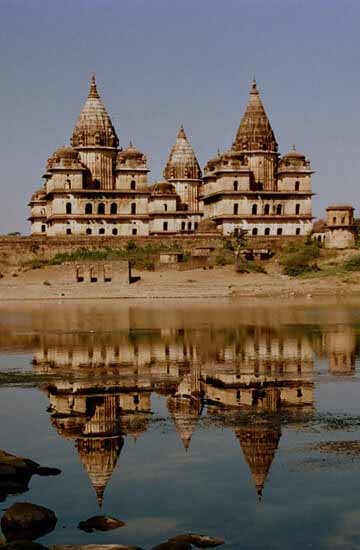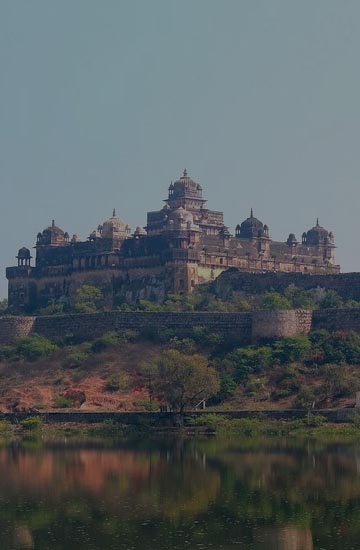Raja Mahal -
Rudra Pratap Singh, the Rajput king of Orchha, started the construction of the Raj Mahal during the 16th century. However, the work of completing the structure was eventually taken up by the successors of Rudra Pratap Singh, the most popular of whom was Madhukar Shah.
It is a square structure in which two wings have five floors on three sides and four floors on one side. The bedrooms of four queens are constructed to the right of the Private audience's hall. The Cabin of the emperor is at the front, at the same level as the Sanctum of the Chatturbhuj Mandir. The ceiling of the royal chamber has been delicately painted with vibrant colors. Many other paintings, illustrating scenes from Ramayana and the glory of Bundela Court are hung on the walls of the palace. Beautifully stone-carved grills give the palace a majestic royal look and the angle shaft allows natural air and light continuously flows through the rooms. There are parts of the palace which have been converted into a Heritage Hotel called Sheesh Mahal, open for the tourists to stay while they explore the sites of Orchha. The interior of the palace is decorated with fragments of mirrors and includes lavish royal accommodation. These marvelous architectures stand tall inside the Orchha fort complex and enthrall its visitors.
Rani Mahal +
Rani Mahal, situated in the beautiful town of Orchha, is a viewpoint from where one can take a glimpse of the entire city as well as that of the river Betwa. Wonderfully constructed, the Rani Mahal is a sophisticated structure showcasing yet another piece of adorable architecture. The Rani Mahal is widely known for the paintings on the walls of the palace. It is called the Queen's chamber for it was the residence of the begum of King Madhukar Shah. The queen was a great devotee of lord Rama and hence one can witness unique paintings inside the palace depicting scenes from the epic Ramayana.
Laxmi Narayan Temple +
The history of the temple goes back to the Bundela dynasty. This temple is a square structure built by King Veer Singh Deo in 1622. The outer walls of the temple have the window like carvings and they are topped with battlements. The courtyard is surrounded by walls with galleries that run throughout them and are open to the sky. A hall is located in front of the octagonal sanctum in the centre of the courtyard. The murals that cover the galleries and vaulted roofs are the most artistic feature of the Laxminarayan Temple. The temple has some beautiful paintings on the upper part of the walls. The subjects of the paintings are particularly unusual than that of other paintings in the temple. While some of them illustrate episodes from the Ramayana, and of Lord, the eighth incarnation of Lord Vishnu, others depict mythical, martial and secular scenes. There is an outstanding painting of the 'Chungi Chirya', the giant bird that could fly high with an elephant in its claws.
Chhatris +
There are fifteen cenotaphs honoring the Bundela kings and other members of their family on the right bank of the Betwa River in the south. The platform on which the chhatris rise as well as the sanctum are square in shape. The cremated remains of the royal princes and princesses are kept in the sanctums. A marble statue of Madhukar Shah and his wife with a painted canopy can be found in the first chhatri. The last chhatri in the line that can be seen from the riverbank is precisely square in structure which is built to honour Veer Singh Deo.
Chaturbhuj Temple +
The design of the temple is unique in terms of architecture when compared to other structures in Orchha. The dome of the temple is not ribbed but smooth like that of a mosque. The court of the temple is open to the sky and it also has rising towers resembling the Chhatris of the Bundelas. There is a statue of four armed, that is Chaturbhuj, Vishnu inside the temple. It stands on a pedestal which gives the statue a majestic appearance.
Jahangir Mahal +
Jahangir Mahal was built in the 17th century by the Bundela ruler, Veer Singh Deo. It was constructed to honour the first visit of Emperor Jahangir to Orchha. The entry of the palace is marked with a traditional and aesthetic gate. The east-facing front wall of the palace is covered with turquoise tiles. At the entrance, two stone elephants greet you with a bell that marks the entry of the King of that period.
It is believed that this palace is the epitome of Indo-Islamic architecture. The domes have engravings of external ribs which contrast with the internal carving of the Islamic style. The brackets of the windows are made in a wavy style, following Jain architecture. It is impressively decorated with light-colored ceramic tiles. This three-storied building has some amazing sculptures, beautiful balconies, Chhatris and beautifully carved-topped domes that reflect its architectural brilliance.
Shri Ram Raja Temple +
The Ram Raja Temple is the only temple in the country where Lord Rama is worshipped as the King rather than a god. It is also known as Orchha Temple. Shri Ram Raja Temple in Orchha is beautifully painted in hues of white, pink, and yellow.
The legend behind the temple is as vivid as its walls. Madhukar Shah Ju Dev, the ruler of Orchha, was a follower of Lord Krishna, while his wife, Queen Ganesh Kunwari, was a follower of Lord Rama. The Queen once refused the King's request to accompany him to Braj-Mathura because she preferred to go to Ayodhya. The King insisted and invited her to follow him. However, the Queen declined. The monarch was annoyed over this and instructed her to return only when she would be bringing Lord Rama along. When the Queen arrived in Ayodhya, she began to pray to Lord Rama, but the lord did not show up. She finally jumped into the Saryu River at midnight out of desperation. In response to the Queen's prayers and devotion, Lord Rama manifested himself as a child in her lap. Three conditions were set forth by Lord Rama before he decided to leave, "I will travel exclusively in Pushya Nakshatra so that he reaches Orchha with sages; second, Once we reach Orchha, I shall be the King of Orchha; and third, the first place you seat me will be my final place to stay," lord instructed.
When the King came to know that the queen was travelling back to Orchha with Lord Rama, he began work on the temple. The queen, who had just returned from a long journey, chose to go to her room for the night while sitting with Lord Rama in her palace. But in line with Lord Rama's requirements, he assumed the first position and sat down. Thus, the name Ram Raja Temple has remained attached to the queen's palace to this day. When the King learned that the queen was travelling back to Orchha with Lord Rama, he began work on the temple. The queen, who had just returned from a long journey, chose to go to her room for the night while sitting with Lord Rama in her palace. But according to Lord Rama's conditions, he took the first place where he was seated. Thus, from that day to today, the queen's palace is known as Ram Raja Temple.
Betwa River +
Walk down to river Betwa to witness the photo perfect view of the sun go down behind chhatris from the sun set point.
Phool Bagh +
The most beautiful garden of Orchha is a structural demonstration of the testimony of the Bundela rulers who once ruled the city of Orchha. This garden with its eye soothing beauty served in the past as a summer sojourn by the kings of this place. This Bagh was built in memory of the prince of Orchha, Dinman Hardaul. The premise of the Bagh facilitates a resourceful system which enhances water ventilation. It is connected with the Chandan katora fountain. The Badgir Sawan Bhadon Towers also occupy a place in this wonderful garden which was constructed with the objective of providing cooling effects to this Bagh. The plantation in Phool Bagh follows the Mughal style which is one of its kinds. The Phool Bagh therefore has adorable scenic beauty.
Orchha Bird Sanctuary (Optional not included) +
This sanctuary is full of scenic beauty and picturesque landscapes. Spread over an area of 46 sq. km, the Bird Sanctuary has its significance due to its rich fauna, Betwa River and availability of some rare species of plants.
Betwa River rafting (Optional not included) +
The rafting starts from the beautiful Kanchan Ghat and ends at Shiva Ghat. Rafting is quite popular among the adrenaline junkies who want to get a thrilling experience along with Orchha exploration. You can get to see the line of Chhatris while rafting which would give you a thrilling experience of rafting while seeing such historical grandeur.
Nature Trail (Optional not included) +
This 12 Kms long nature trail in the Orchha Natural Reserve can be a beautifully enriching experience. This is part of a beautiful river island spread across 44 sq km surrounded by Jamni River and Betwa River. One need to buy a ticket from the office of the Reserve between 8am-6pm and the entry costs are very low. The trail is well-marked and signposts are regularly posted. It's also a good place to just cycle around. One can also spot few monkeys, peacocks and even antelopes in this area. Turtles could also be spotted near Ret Ghat on the banks of Jamni River.
After the completion of your tour, you will be dropped back to your place within Orchha city limits.



